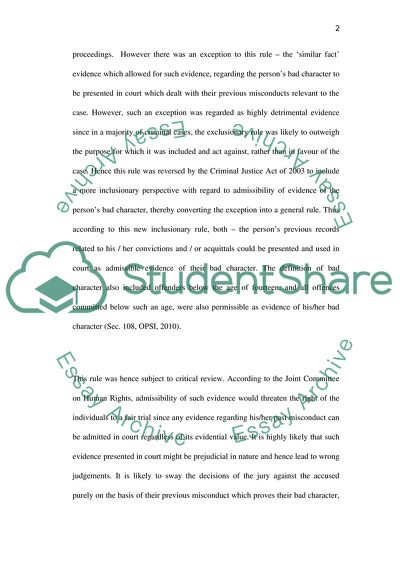Cite this document
(“Criminal Justice Act in 2003 Research Paper Example | Topics and Well Written Essays - 3500 words”, n.d.)
Criminal Justice Act in 2003 Research Paper Example | Topics and Well Written Essays - 3500 words. Retrieved from https://studentshare.org/law/1737961-1critically-evaluate-the-reforms-introduced-by-the-criminal-justice-act-2003-in-relation-to-the-admissibility-of-evidence-of-bad-character-2-it-is-understandable-that-the-courts-in-criminal-cases-need-the-guidance-of-experts-in-area
Criminal Justice Act in 2003 Research Paper Example | Topics and Well Written Essays - 3500 words. Retrieved from https://studentshare.org/law/1737961-1critically-evaluate-the-reforms-introduced-by-the-criminal-justice-act-2003-in-relation-to-the-admissibility-of-evidence-of-bad-character-2-it-is-understandable-that-the-courts-in-criminal-cases-need-the-guidance-of-experts-in-area
(Criminal Justice Act in 2003 Research Paper Example | Topics and Well Written Essays - 3500 Words)
Criminal Justice Act in 2003 Research Paper Example | Topics and Well Written Essays - 3500 Words. https://studentshare.org/law/1737961-1critically-evaluate-the-reforms-introduced-by-the-criminal-justice-act-2003-in-relation-to-the-admissibility-of-evidence-of-bad-character-2-it-is-understandable-that-the-courts-in-criminal-cases-need-the-guidance-of-experts-in-area.
Criminal Justice Act in 2003 Research Paper Example | Topics and Well Written Essays - 3500 Words. https://studentshare.org/law/1737961-1critically-evaluate-the-reforms-introduced-by-the-criminal-justice-act-2003-in-relation-to-the-admissibility-of-evidence-of-bad-character-2-it-is-understandable-that-the-courts-in-criminal-cases-need-the-guidance-of-experts-in-area.
“Criminal Justice Act in 2003 Research Paper Example | Topics and Well Written Essays - 3500 Words”, n.d. https://studentshare.org/law/1737961-1critically-evaluate-the-reforms-introduced-by-the-criminal-justice-act-2003-in-relation-to-the-admissibility-of-evidence-of-bad-character-2-it-is-understandable-that-the-courts-in-criminal-cases-need-the-guidance-of-experts-in-area.


